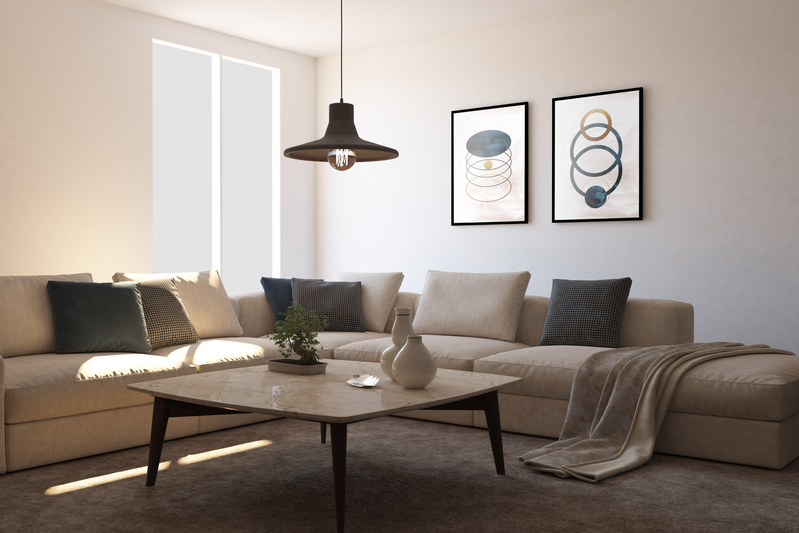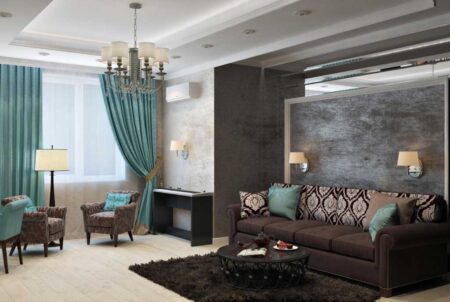When designing your living room, selecting the right furniture is crucial. Your living room is where you relax, entertain guests, and spend quality time with your family. The furniture you choose should be aesthetically pleasing but also functional and comfortable. This guide will walk you through the steps to select the perfect furniture pieces for your living room.
Choosing the right furniture for your living room can be a daunting task, but there are several steps you can take to make the process easier. Here are some tips from various sources:
- Make a plan: Before you start shopping for furniture, make a plan for your living room. Consider the room’s natural architecture, such as built-in design elements, and measure the dimensions of the space. Decide on a central focal point and begin placing furniture from there.
- Consider the scale of your room: When choosing furniture, consider the scale of your room. Large furniture can overwhelm a small space, while small furniture can look lost in a large room.
- Choose a theme: Pick an appropriate theme for your home and apply it to every room to create a cohesive design. Choosing a theme makes it easier to choose furniture that compliments each other.
- Think about durability: When choosing furniture, think about durability. Consider what the furniture is made of, whether it compliments other pieces in your home, and if it fits within the dimensions of the space you are trying to create.
- Stick to your budget: Stick to your budget when choosing furniture. Decide how much you can afford and look for pieces that fit your budget.
- Get advice from experts: If you feel overwhelmed, get advice from experts. Consider consulting with an interior designer or furniture expert to help you make the right decision.
Following these tips, you can choose the right furniture for your living room that creates a pleasant, welcoming appearance while holding up against the wear and tear of everyday life.
Assess Your Space
Before shopping for furniture:
- Look closely at your living room’s dimensions and layout.
- Measure the available space to determine the dimensions you’re working with. This step will prevent you from purchasing furniture that’s either too large or too small for your room.
- Consider the placement of doors, windows, and outlets, as these factors will also impact furniture arrangement.
Consider the age and style of the property
Choosing furniture that complements the age and style of the property can help you enhance the best features of your living spaces and create cohesive designs. There’s nothing wrong with mixing old and new and blending different styles and themes, but it’s always a great idea to take inspiration from the type of property. Center city apartments tend to lend themselves to chic, contemporary furniture while traditional and vintage pieces are ideal for period properties. Consider the overall aesthetic you want to achieve and think about whether you want your home to flow or you’d prefer distinctive areas. You might want to experiment with multiple trends if you want every space to be unique or stick to a simpler design blueprint if you want all your rooms to complement each other.
When you’re shopping for furniture for your living room, focus on color, style and materials. It’s beneficial to create a mood board and conjure up and collate ideas before you buy new pieces or upcycle existing items.
Define Your Style
Everyone has a unique style; your living room furniture should reflect that. Are you drawn to a modern, minimalist look or prefer a cozy, traditional ambiance? Research different interior design styles to find the one that resonates with you. It will help narrow your furniture choices and create a cohesive look in your living room.
Choose a Focal Point
Selecting a focal point for your living room helps in guiding furniture placement. It could be a fireplace, a large window with a beautiful view, or even a stylish media console. Arrange your furniture around this focal point to create a harmonious and inviting arrangement.
Consider comfort

Your living room is a space for relaxation and socializing, so comfort is paramount. When choosing furniture pieces like sofas and chairs, prioritize comfort over aesthetics. Look for pieces with high-quality cushions and supportive frames. Test out the furniture in person to gauge how comfortable it is for sitting and lounging.
Determine functionality
Consider how you intend to use your living room. Will it primarily serve as a space for family movie nights, formal entertaining, or a combination of both? Select furniture that aligns with your lifestyle. If you frequently host guests, consider a sectional sofa or a combination of seating options. If you value multifunctionality, opt for coffee tables with storage or ottomans that can serve as extra seating.
Coordinate Colors and Fabrics
Your furniture’s color scheme and fabric choices should complement the room’s overall aesthetic. If unsure, neutral tones like beige, gray, and white are versatile options that work well with various design styles. Incorporate pops of color through accent pillows and throws. Make sure the fabric is durable and easy to clean, especially if you have children or pets.
Mix and Match
Gone are the days of matching furniture sets. Mixing and matching different furniture pieces can add visual interest and personality to your living room. However, ensure a unifying element, such as a standard color or design style, to maintain a cohesive look.
Scale and Proportion
Maintaining proper scale and proportion is crucial for a balanced living room layout. Avoid overcrowding the room with oversized furniture, which can cramp the space. On the other hand, too-small furniture can look out of place. Find the right balance by choosing furniture that fits comfortably within the room’s dimensions.
Budget Wisely
Furniture shopping can quickly become overwhelming, especially when numerous options are available. Set a budget before shopping to help you narrow your choices. While splurging on certain pieces is tempting, remember that quality and functionality should always come first.
Read Reviews and Test Quality
Before purchasing, read reviews from other buyers to gauge the quality and durability of the furniture you’re interested in. Well-constructed furniture will stand the test of time, saving you money in the long run. Visit furniture stores in person to test the quality and comfort firsthand.
In conclusion, choosing the right furniture for your living room involves a thoughtful combination of style, functionality, comfort, and practicality. By assessing your space, defining your style, and considering factors like comfort and functionality, you can create an aesthetically pleasing living room that reflects your lifestyle. Take your time, do your research, and invest in pieces that will enhance the overall ambiance of your living space.
FAQ

1. How to match furniture in a living room? Matching furniture in a living room involves creating a cohesive and harmonious look. You can achieve this by considering color schemes, design styles, and proportions. Opt for a consistent color palette and design theme throughout the room. Mixing and matching different furniture pieces with similar colors or design elements can add visual interest while maintaining a unified feel.
2. What furniture should be in the living room? The furniture in a living room typically includes essentials such as a sofa or couch, chairs, a coffee table, an entertainment center or TV stand, and storage solutions. Depending on your space and lifestyle, you might consider adding accent tables, bookshelves, and seating options like ottomans or benches.
3. How do I choose the right furniture for my house? Choosing the right furniture involves assessing your needs, style preferences, and the available space. Consider factors like the room’s dimensions, your required functionality, and your personal aesthetic. Research different furniture stores and options, read reviews, and test the quality and comfort of pieces whenever possible before deciding.
4. Does all furniture have to match in the living room? No, not all furniture has to match in the living room. In fact, mixing different furniture pieces can create a more eclectic and dynamic look. While it’s important to maintain some level of cohesion, you can achieve this by incorporating common design elements such as color tones or styles. Mixing furniture allows for more personal expression and creates a more visually appealing and unique space.






